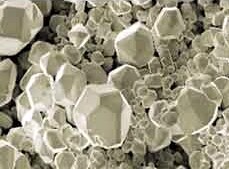
sulfation crystals of PbSO4
L. David Roper
http://www.roperld.com/personal/roperldavid.htm
January 2008
This purpose of this article is to make it easy to find information about battery sulfation for lead-acid batteries.
.
sulfation crystals of PbSO4
"The sulfation process took weeks or months to develop. The desulfation process will take the same order of magnitude of time. Don't expect to put the battery on desulfate today and back in the airplane tomorrow. I've left batteries on this system for a month before I was happy with the end result."Ref
"Pulse Technology (Tuned to the molecular frequency of the sulphur crystal of 3.26 MHz. ... a point at which the chemical bonds that hold the molecules together to form a crystal can be broken.) allows the user to electronically dissolve sulfation formations back into the electrolyte solution without taking the battery out of service. Most importantly, if used on a regular basis, Pulse Technology will help keep the lead plates free and clean of sulfate crystals allowing it to operate unhampered at full capacity. This process generates little or no heat (to "boil" the acid away), and can in no way harm the battery itself. ... Not every battery is a candidate for re-conditioning due to mechanical damage caused by vibration or contamination, which has created is "shorted" cells. If a 12 volt battery has a resting voltage of at least 10.5V and none of the 6 cells are shorted, de-sulphation of its plates can be accomplished. ... Often by the time an aeromotive battery fails a load test due to sulfation, the battery plates are heavily eroded, the plate materials having fallen to the bottom of the battery. This occurs because the plates are manufactured to be of high porosity (much like a piece of Swiss cheese), to maximize surface area and to allow maximum amperage discharge for a short period of time e.g. starting your aircraft's engine). This allows construction of a compact battery with short term, high amperage capability. The sulfate enters the pores on the plates, and as it advances towards the crystalline state, it greatly expands. The crystal growth causes plate materia1 to break off much the same way as the formation of ice in a crack of a rock will cause pieces of the rock to break off. ... De-Sulfation is not an over-night process. The larger the plate area and/or the more sulfation present, the longer it takes to remove same, simple. ... The typical de-sulfation process can take upwards of several weeks (or longer) for larger batteries, when doing several batteries at once, and for those with severe sulfation. This is why many users purchase more than one unit so as to effectively effectively treat/condition more than one battery at any given time. Repetitive de-sulfation conditioning is recommended every few months depending on battery temperature and periods of in-activity etc."Ref